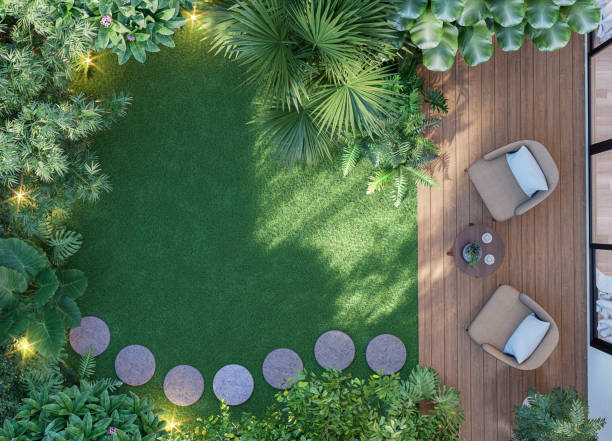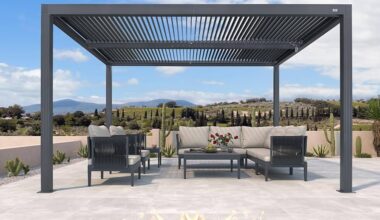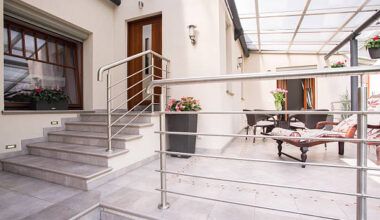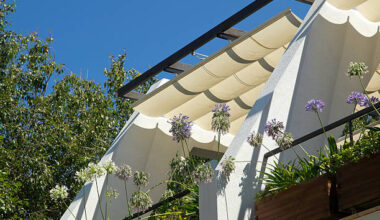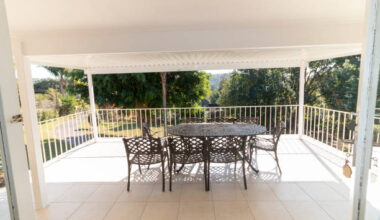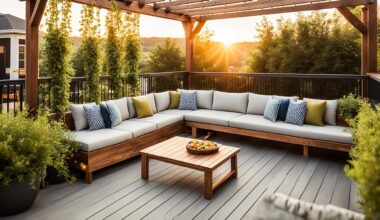Imagine a harmonious fusion of nature and architecture, where a pergola seamlessly integrates into the earth, becoming an enchanting extension of your outdoor paradise. Today, we dive into the captivating realm of in-ground pergolas, uncovering the top seven design and construction considerations that will elevate your outdoor living experience to new heights.
Prepare to immerse yourself in the world of captivating outdoor architecture as we embark on a design and construction odyssey, exploring the intricacies of in-ground pergolas.
By the end of this journey, you will possess the knowledge and expertise to create a breathtaking oasis that seamlessly merges with nature, elevating your outdoor living experience to unprecedented levels of beauty and serenity.
Get ready to transform your outdoor oasis with an in-ground pergola that fits your style and provides endless freedom of enjoyment.
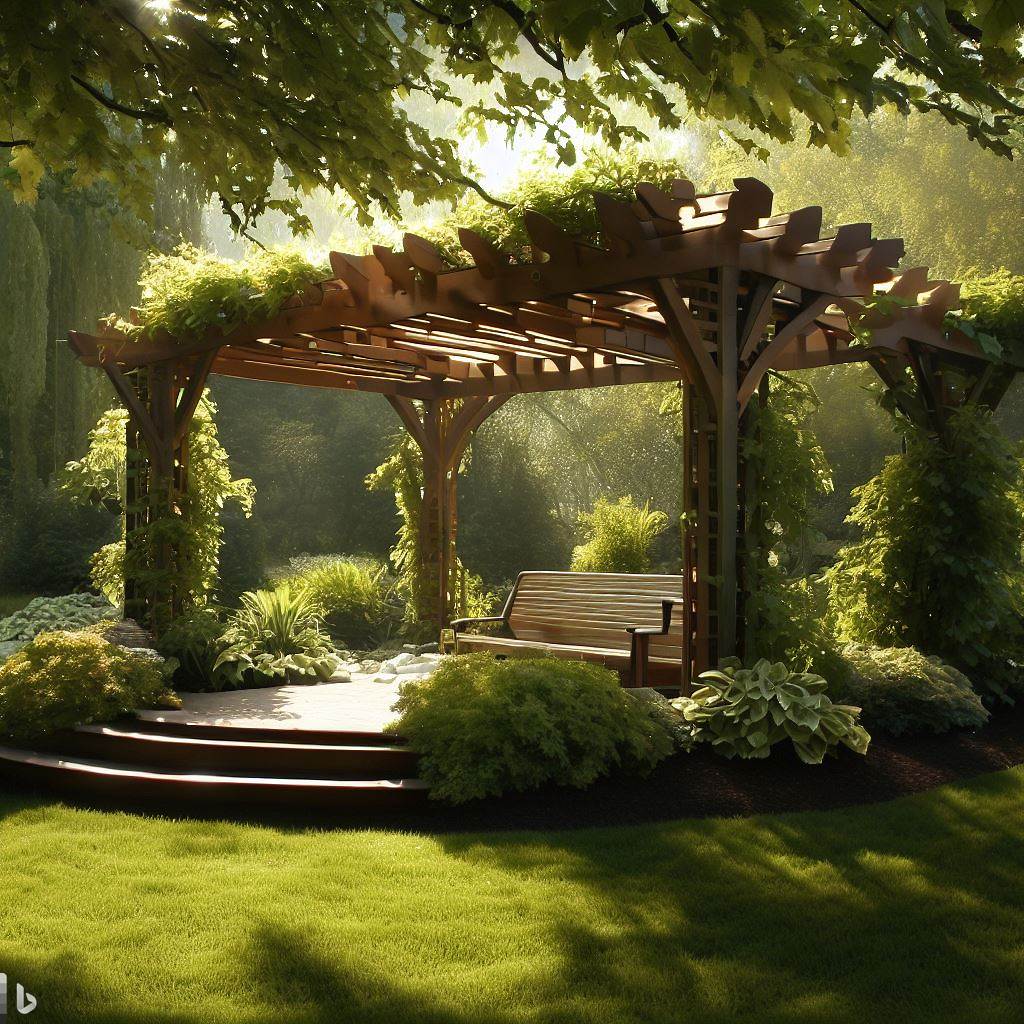
Key Takeaways
- Design style and purpose influence the size, shape, and layout of a pergola.
- Proper placement maximizes shade, privacy, and complements landscaping.
- Structural stability is essential for safety, including footings, anchoring, and load-bearing capacity.
- Regular maintenance and care are important to keep the in-ground pergola looking its best.
1. Determine Your Design Style and Purpose
Designing an in-ground pergola involves determining the style and purpose that align with your preferences and needs. Whether you envision a modern, sleek structure or a rustic, natural one, identifying your design style will help guide the construction process.
Consider factors like your outdoor space, existing architecture, and personal taste to determine the overall aesthetic of your pergola. Additionally, think about how you plan to use the space—will it be for entertaining guests, creating a cozy outdoor retreat, or growing plants?
Understanding this will assist in making practical decisions during the planning phase. As we move forward into choosing the right materials for your in-ground pergola, let’s explore how different designs can complement various purposes seamlessly.
2. Choose the Right Materials
Make sure you pick the perfect materials for your in-ground pergola to create a stunning and durable structure that will enhance your outdoor space. Here are four key factors to consider when choosing the right materials:
- Weather resistance: Select materials that can withstand different weather conditions, such as rain, wind, and extreme temperatures. Look for options like cedar or pressure-treated wood, which offer excellent durability.
- Maintenance requirements: Consider how much time and effort you’re willing to invest in maintaining your pergola. Some materials, like vinyl or aluminum, require minimal upkeep compared to wood.
- Aesthetic appeal: Choose materials that align with your design style and complement your existing outdoor decor. You can opt for natural wood finishes or explore alternative options like fiberglass or composite materials.
- Longevity: Invest in high-quality materials that will stand the test of time. Look for warranties and product reviews to ensure you’re getting a reliable and long-lasting option.
Having said that, let’s move on to the concept of proper placement. Understanding proper placement is crucial when constructing an in-ground pergola…
3. Understand Proper Placement
Choosing the perfect location for your in-ground pergola is essential to create a captivating outdoor oasis. Consider factors such as
- sunlight exposure
- wind direction
- proximity to other structures or trees.
Placing your pergola in an area with ample sunlight will provide a warm and inviting atmosphere throughout the day. Additionally, positioning it away from strong winds will ensure that you can enjoy its shade without feeling uncomfortable breezes.
Keep in mind any nearby structures or trees that may obstruct the view or cast unwanted shadows on your pergola. By carefully selecting the placement of your in-ground pergola, you can maximize its aesthetic appeal and functionality.
Furthermore, ensuring structural stability is another crucial factor for a long-lasting and safe outdoor structure that will withstand various weather conditions and bring joy for years to come.
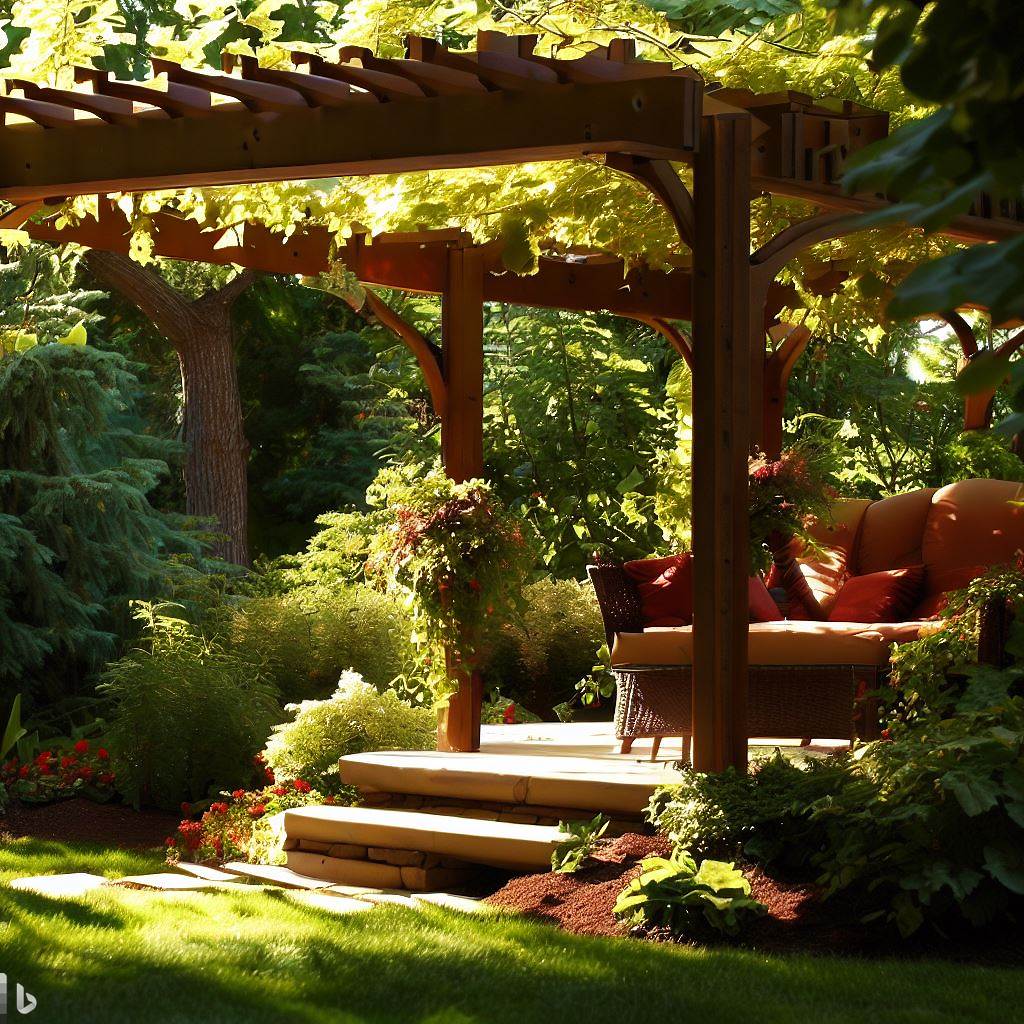
4. Ensure Structural Stability
To ensure your in-ground pergola stands strong against the elements, carefully assess the stability of its structure. Begin by checking the materials used for construction. Opt for sturdy and durable materials such as pressure-treated wood or metal posts.
Make sure the foundation is solid and secure, using concrete footings that are deep enough to withstand wind and other forces. Additionally, consider adding cross beams or braces for added stability. It’s important to follow local building codes and regulations to ensure a safe and structurally sound pergola.
By taking these measures, you can enjoy your outdoor space without worrying about the integrity of your pergola. As you plan for lighting and accessories, keep in mind how they will integrate seamlessly into your stable structure.
Now that you have ensured the structural stability of your in-ground pergola…
5. Plan for Lighting and Accessories
Creating the perfect ambiance is essential for enjoying your space day or night. Consider incorporating these elements:
- Outdoor Lighting: Install soft, warm lights around the perimeter of your pergola to create a cozy atmosphere. String lights or solar-powered lanterns are popular choices.
- Comfortable Seating: Choose comfortable seating options such as plush cushions or weather-resistant furniture to make your pergola a relaxing retreat.
- Functional Accessories: Add practical accessories like a built-in grill or mini bar to enhance the functionality of your outdoor area.
By carefully selecting lighting and accessories that align with your style and needs, you can transform your in-ground pergola into an inviting sanctuary. The next question to ask from here is, how does all of these come together to impact your budget and timeline for construction?
6. Budget and Timeline
As you envision your outdoor oasis, it’s important to visualize a realistic budget and timeline for bringing your dream space to life. Consider the costs of materials, labor, and any additional features or accessories you want to include in your in-ground pergola project.
Research prices and compare quotes from different suppliers and contractors to ensure you’re getting the best value for your money. It’s also crucial to determine a timeline for the construction process, taking into account factors such as weather conditions and availability of skilled laborers.
By setting a budget and timeline upfront, you can have a clear understanding of what is feasible within your means and avoid any unexpected delays or expenses down the line. That also brings into question the conflict between diy vs. professional installation. Which one is better?
7. DIY vs. Professional Installation
When considering whether to tackle the installation of an in-ground pergola yourself or hire a professional, it is important to assess your skills and experience.
While some DIY enthusiasts may have the necessary expertise for a simple pergola design, complex designs or structural requirements may warrant hiring a professional. By evaluating your abilities honestly and considering the complexity of the project, you can make an informed decision that will ensure a successful outcome.
Assess Your Skills and Experience
Building a pergola requires certain knowledge and abilities, so it’s important to determine if you have what it takes to successfully complete the project. Consider the following:
- Carpentry Skills: Do you have experience with woodworking, measuring, cutting, and assembling materials?
- Construction Knowledge: Are you familiar with building codes, permits, and structural requirements?
- Time Commitment: Can you dedicate the necessary time to plan, gather materials, and complete the construction process?
- Physical Ability: Are you physically capable of handling heavy materials and performing manual labor?
Assessing your skills will help determine whether DIY is the right route for you. If any of these areas are lacking or if you want a complex design or have specific structural requirements, consider hiring a professional who can ensure a successful outcome.
Hiring a Professional for Complex Designs or Structural Requirements
If you’re looking for a truly unique and intricate outdoor structure, it may be worth considering hiring a professional who specializes in complex designs or structural requirements. Building an in-ground pergola that is both visually stunning and structurally sound can be a challenging task.
Professionals have the expertise to understand the complexities involved in designing and constructing such a project. They can provide valuable insights, offer innovative design ideas, and ensure that all structural requirements are met.
By entrusting this job to a professional, you can rest easy knowing that your in-ground pergola will not only meet your aesthetic preferences but also stand the test of time. However, whether you do it yourself or hire a professional, you’ll still need to maintain your structure.
In the next section about maintenance and care, we will discuss how to keep your newly built pergola continually looking its best.
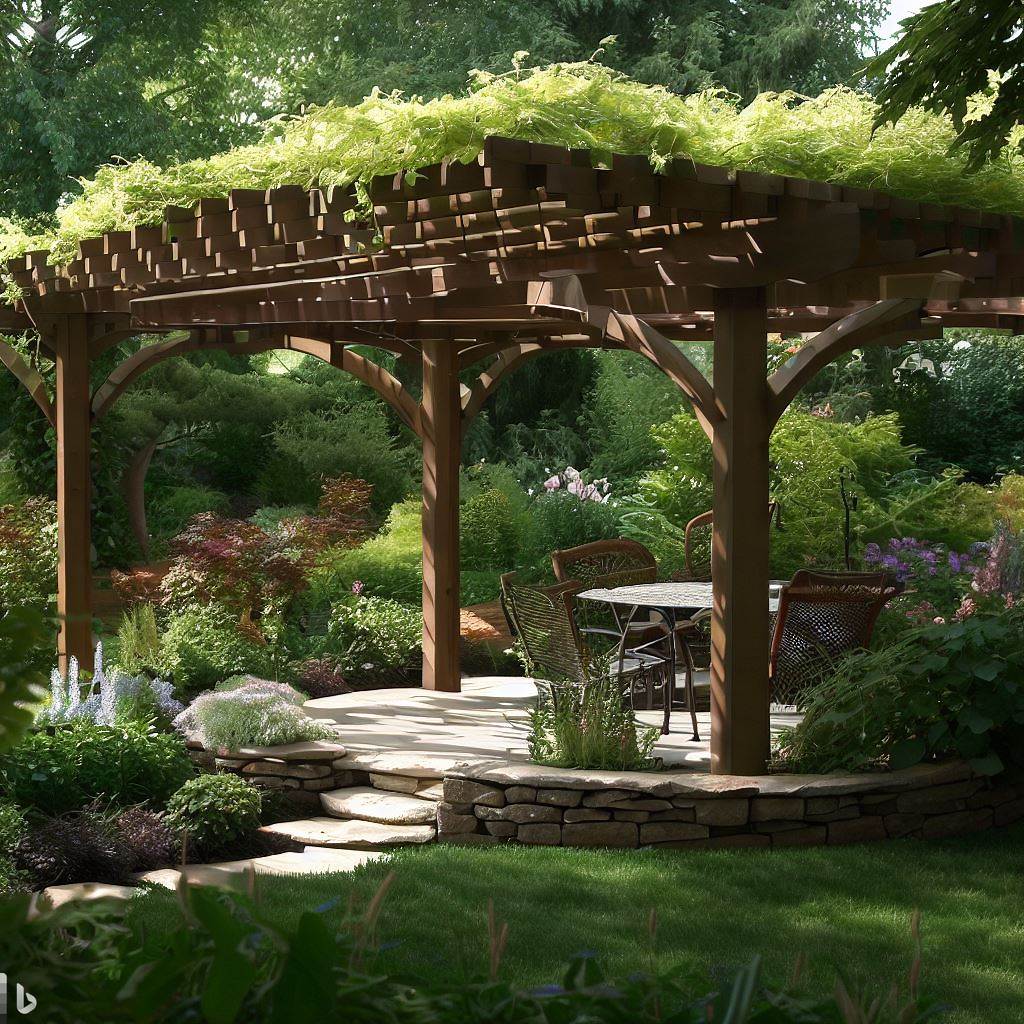
Maintenance and Care
To keep your in-ground pergola looking its best, it’s important to regularly clean and seal the wood. This will help protect it from weathering and prolong its lifespan. Here are some maintenance tips to consider:
- Cleaning:
- Use a mild detergent mixed with water to gently scrub away dirt and grime.
- Rinse thoroughly with water and allow it to dry completely before applying any sealant.
- Sealing:
- Choose a high-quality wood sealant that is specifically designed for outdoor use.
- Apply the sealant evenly using a paintbrush or roller, following the manufacturer’s instructions.
- Allow sufficient drying time before using the pergola again.
By following these simple maintenance steps, you can ensure that your in-ground pergola remains beautiful and functional for years to come. Remember, taking care of your pergola not only enhances its appearance but also protects your investment.
Conclusion
The world of in-ground pergolas opens up a realm of endless possibilities for outdoor enthusiasts and design aficionados. By carefully considering the design and construction considerations, you can transform your outdoor space into a captivating oasis that seamlessly integrates with the natural landscape.
Now armed with the knowledge and expertise gained from our exploration of design and construction considerations, you have the tools to bring your vision to life. Embrace the fusion of architecture and nature, and let the in-ground pergola become the centerpiece of your outdoor haven.
May your design dreams flourish, and may your in-ground pergola become a symbol of tranquility, beauty, and endless enjoyment in the embrace of the great outdoors.
FAQs On In-Ground Pergola
Q: What is a pergola?
A: A pergola is an outdoor structure that consists of columns or posts supporting a roof made of beams and rafters. It is commonly used to create a shaded area in a backyard or garden.
Q: What are the top considerations when designing and constructing an in-ground pergola?
A: When designing and constructing an in-ground pergola, there are several key considerations to keep in mind. These include the type of footing, the method of attachment to the ground, the choice of materials, the size and layout of the pergola, and the overall design aesthetic.
Q: How do I choose the right footing for my in-ground pergola?
A: The choice of footing for an in-ground pergola will depend on factors such as the soil type, the climate, and the size and weight of the pergola. Common options include concrete footings, concrete piers, and concrete slabs.
Q: How do I attach a pergola post to a concrete patio?
A: To attach a pergola post to a concrete patio, you will need to use a post base or post anchor. This hardware is typically fastened to the bottom of the post using lag screws, and then secured to the concrete surface using concrete anchors.
Q: What should I consider when installing pergola footings?
A: When installing pergola footings, it is important to consider factors such as the depth of the footing, the distance between the footings, and the method of anchoring. It is also important to ensure that the footings are level and plumb.
Q: Can I install a pergola on a concrete patio?
A: Yes, it is possible to install a pergola on a concrete patio. This can be done by attaching the pergola posts to the concrete surface using post bases or post anchors.
Q: How do I anchor a pergola to the ground?
A: To anchor a pergola to the ground, you can use various methods such as attaching the pergola posts to concrete footings or piers, or using ground anchors or stakes to secure the pergola directly to the soil.
Q: What are the different footing options for a pergola?
A: The footing options for a pergola include concrete footings, concrete piers, and concrete slabs. The choice of footing will depend on factors such as the soil type, the climate, and the size and weight of the pergola.
Q: How do I ensure that the pergola posts are securely attached to the footings?
A: To ensure that the pergola posts are securely attached to the footings, it is important to use appropriate hardware such as post bases or post anchors. These should be properly installed and tightened to ensure a strong connection.
Q: Can I build a pergola myself?
A: Yes, it is possible to build a pergola yourself. However, it is important to have some knowledge and experience in construction, as well as access to the necessary tools and materials.
Q: Do I need to dig footings for a pergola?
A: In most cases, it is recommended to dig footings for a pergola. This helps to provide a stable and secure foundation for the structure. The depth and size of the footings will depend on factors such as the soil type, the climate, and the size and weight of the pergola.
